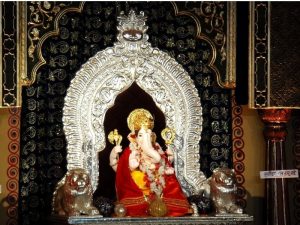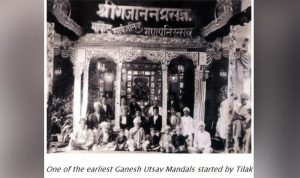Maharashtrians have more affinity towards Lord Ganesha. According to the historian Shri Rajwade, the earliest Ganesh Chaturthi celebrations can be traced back to the times of the reigns of dynasties such as Satavahana, Rashtrakuta and Chalukya. The Ganesha Purana and the Mudgala Purana are the two sacred Hindu religious texts dedicated to the deity Lord Ganesha that includes many stories and ritualistic elements relating to Ganesha. These two puranas are core scriptures for devotees of Ganesha, known as Ganapatyas (Gāṇapatya). They are composed sometimes between AD 15th to 18th century, during a period of conflict between the Hindu Maratha and Islamic Sultanates in Maharas htra.
htra.
There are some historical evidences that the founder of the Maratha Empire Chhatrapati Shivaji first started celebrating Ganesh Chaturthi with great enthusiasm since Lord Ganesha was the Kuladevata (family god) of the Peshwas. It seems the festival used to be publicly celebrated in Pune during Shivaji Maharaja’s era between AD 1630–1680 by the emperor for gathering and uniting his people for freedom from Mugals.
The Peshwas who inherited administration of the Maratha Empire from 1718 until its end in 1818 encouraged the celebrations in their capital, Pune, since Ganesha was their family deity (Kuladevata). With the fall of the Peshwas, the Ganesha festival lost state patronage and became a private family celebration in Maharashtra. People celebrated Ganesh festivals in their homes. It was revived by Indian freedom fighter and social reformer Lokmanya Tilak almost 200 hundred years later, after Peshwas.
Tilak was inspired by Chatrapati Shivaji, he also used the occasion to stimulate and motivate the people of Maharashtra for freedom against the British. The 1857 revolt against Britishers was very successful in communicating to struggling Indians the message of independence. Freedom fighters were looking at ways and mean s to take the movement forward. During 1870s to 1890’s British passed numerous orders to prohibit public gathering of Indians preventing more than 20 people from gathering. The only exception to this was Friday assemblies at the mosque, allowed under pressure from Muslim quarters to allow for Namaz.
s to take the movement forward. During 1870s to 1890’s British passed numerous orders to prohibit public gathering of Indians preventing more than 20 people from gathering. The only exception to this was Friday assemblies at the mosque, allowed under pressure from Muslim quarters to allow for Namaz.
Lokmanya Tilak who was regarded as the Great rebellion and was regarded as ‘father of Indian unrest’ was seeking ways to create a platform to unite people. He selected Ganesha Chaturthi as the medium of religious significance to get the required exception to the ordinance and allow public gatherings. Like the Muslims used to get for their Friday Namaz. Lord Ganesha was particularly selected because HE is the only deity who is worshipped by all sects in the Hindu society among the Bramhins and non Bramhins, and various sub castes of internally divided Hinduism. In 1892 Lokmanya Tilak’s publication Kesari carried out announcements of the cultural festival and he erected Ganesha idol and started immersion 10 days later. His followers’ and squad put hoardings across Mumbai and Pune to gather people and freedom fighters would speak at these gatherings. In fact, Ganesh Chaurthi festival meant everything to the people because their freedom was dependent on it. This is how Lord Ganesha played an important role in uniting people for the freedom fight of the country, and Ganesh Chaturthi is celebrated with full fan fare year after year, even today.
Ganesh Chaturthi was the platform to induce the patriotism among people of Maharashtra. Tilak was able to bring a feeling of unity among the masses against the British through the festive zeal as opposed to a political gathering that the British would not allow. The festival was first celebrated in Mumbai city in Keshavji Naik Chawl Sarvajanik Ganeshotsav Mandal, which is the first and oldest mandal that came into being at Girgaum, since 1893.
Within a decade, the spirit of the festival spread like wildfire with more and more mandals coming up in small pockets at Dadar, Parel and Girgaum. People from different religions finally had 10 days to interact with each other without the nosy Britishers obstructing their meetings. Those days between 1940 to 1950 independence and nationalism became central theme of Ganesh festival. While the festival rituals continued to be simple, the pandal themes were related to the first and Second World War which showed a sign of a progressive society.
A mention needs to be made here that an idol of Lord Ganesha was found near the house of Vinayak Thakar, in Kasba Peth, Pune who used to reside close to the residence of Masaheb Jijabai Bhosale, mother of Shivaji Maharaj. The temple was built by Shivaji Maharaj and his mother in the year 1639. Therefore during the immersion process at the end of the 10th day, Shri Kasba Ganapati leads the immersion process. Only after the idol from this mandal is immersed can the other mandals begin theirs.
Hats off to the visionaries Shivaji Maharaj and Bal Gangadhar Tilak who created patriotic spirits in the society during the Ganesh Festival, this could be the reason why Lord Ganesha is more revered by people in Maharashtra, India.












































